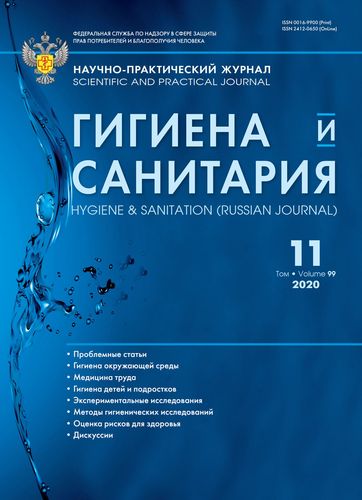Methodical approaches to the substantiation of accommodation of the object for food products in the boundaries of sanitary-protective zones of enterprises of other lines of the industry
- 作者: May I.V.1, Vekovshinina S.A.1, Kleyn S.V.1, Nikiforova N.V.1
-
隶属关系:
- Federal Scientific Center for Medical and Preventive Health Risk Management Technologies
- 期: 卷 99, 编号 11 (2020)
- 页面: 1308-1314
- 栏目: DISCUSSIONS
- ##submission.datePublished##: 24.12.2020
- URL: https://archivog.com/0016-9900/article/view/638480
- DOI: https://doi.org/10.47470/0016-9900-2020-99-11-1308-1314
- ID: 638480
如何引用文章
全文:
详细
Introduction. In conditions of the high density of urban development, efficient use of municipal lands is of particular relevance. Food production facilities make up a significant sector of many cities’ economy, including centers of ferrous and non-ferrous metallurgy, chemistry, petrochemistry, mining, etc., i.e., settlements where significant areas are limited in use by sanitary protection zones. Resolution of the Government of the Russian Federation dated March 3, 2018, No. 222. However, such a justification is a scientific and methodological problem since there is no regulatory consolidation of the procedure.
The purpose of the study was to develop and practically test methodological approaches to justification the admissibility (inadmissibility) of placing a food production facility in the sanitary protection zone of enterprises in other line of the industry.
Material and methods. Design and technical documentation were studied on sources of data on air quality at the industrial site and indoors, and the quality of food products. Authors performed hygienic assessment of the safety and quality of air, raw materials, water, and manufactured food products for compliance with sanitary requirements and standards. When analyzing potential threats to contamination of food products, a mechanism was used to isolate critical points of the technological process.
Results. An algorithm for the formation of the evidence base of the absence (presence) of the negative impact on food quality, the fact of the location of the production facility in the sanitary protection zone of a large industrial enterprise on the quality of food products is proposed. On the example of the production of juices from natural concentrated products, each step of the algorithm has been worked out: analysis of the technological process of production; hazard identification, instrumental measurements of the quality of environmental objects and raw materials and products.
Conclusion. The proposed algorithm allows creating a reliable evidence base for deciding on the admissibility (inadmissibility) of the location of the food production facility in the sanitary protection zone of the enterprise with a different type of activity, tested in real conditions of a large industrial unit. The algorithm can be used as a base for the widespread use and further improvement.
作者简介
Irina May
Federal Scientific Center for Medical and Preventive Health Risk Management Technologies
编辑信件的主要联系方式.
Email: noemail@neicon.ru
ORCID iD: 0000-0003-0976-7016
俄罗斯联邦
Svetlana Vekovshinina
Federal Scientific Center for Medical and Preventive Health Risk Management Technologies
Email: veksa@fcrisk.ru
ORCID iD: 0000-0002-4833-0792
Head of the laboratory of methods of conformity assessment and consumer expertise, Federal Scientific Center for Medical and Preventive Health Risk Management Technologies, Perm, 614045, Russian Federation.
e-mail: veksa@fcrisk.ru
俄罗斯联邦Svetlana Kleyn
Federal Scientific Center for Medical and Preventive Health Risk Management Technologies
Email: noemail@neicon.ru
ORCID iD: 0000-0002-2534-5713
俄罗斯联邦
Nadejda Nikiforova
Federal Scientific Center for Medical and Preventive Health Risk Management Technologies
Email: noemail@neicon.ru
ORCID iD: 0000-0001-8060-109X
俄罗斯联邦
参考
- Rybakov F.F. Saint-Petersburg industry: structural movements and new trends. Innovatsii. 2013; (8): 79–82. (in Russian)
- Oborin M.S., Sheresheva M.Yu., Shimuk O.V. Food security of small towns. Vestnik UrFU. Seriya: Ekonomika i upravlenie. 2017; 16(5): 827–48. https://doi.org/10.15826/vestnik.2017.16.5.040 (in Russian)
- Kiryakina Yu.Yu., Luchnikova N.M. The economic efficiency of environmental protection measures by the example of the Petropavlovskiy district of the Altai region. Vestnik Altayskogo gosudarstvennogo agrarnogo universiteta. 2016; (5): 171–4. (in Russian)
- Davidenko P.N. Updating of SNIP 2.07-01.89 «Urban development. Urban and rural planning and development». Gradostroitel’stvo. 2011; (4): 71. (in Russian)
- Damurchiev V.N. Land use in the city requires rational regulation. Natsional’nye interesy: prioritety i bezopasnost’. 2007; 3(9): 73–4. (in Russian)
- Belousov S.A. The ratio of public and private interests in land law. Vestnik Saratovskoy gosudarstvennoy yuridicheskoy akademii. 2019; (4): 246–51. (in Russian)
- Smith L.C., El Obeidb A.E., Jensenb H.H. The geography and causes of food insecurity in developing countries. Agric. Econ. 2000; 22(2): 199–215.
- Harberger A. Corporation tax incidence: Reflections on what is known, unknown and unknowable. In: Diamond J.W., Zodrow G R., eds. Fundamental Tax Reform: Issues, Choices, and Implications. Cambridge: MIT Press; 2008: 283–307.
- Nikolaeva E.V., Belova I.A. Institutional factors of success of medium-sized enterprises in Chelyabinsk region. Vestnik Chelyabinskogo universiteta. 2014; (21): 159–76. (in Russian)
- Potoroko I.Yu., Kalinina I.V. Food safety as a factor in consumer safety. Vestnik Yuzhno-Ural’skogo gosudarstvennogo universiteta. Seriya: Ekonomika i menedzhment. 2007; (10): 77–81. (in Russian)
- Prüss-Ustün A., Vickers C., Haefliger P., Bertollini R. Knowns and unknowns on burden of disease due to chemicals: A systematic review. Environ. Health. 2011; 10: 9. https://doi.org/10.1186/1476-069x-10-9
- Feron V.J., Groten J.P. Toxicological evaluation of chemical mixtures. Food Chem. Toxicol. 2002; 40(6): 825–39. https://doi.org/10.1016/s0278-6915(02)00021-2
- Schwitzguébel J.P., Kumpiene J., Comino E., Vanek T. From green to clean: A promising and sustainable approach towards environmental remediation and human health for the 21st century. Agrochimica. 2009; 53(4): 209–37.
- Tutel’yan V.A., Nikityuk D.B., Khotimchenko S.A. Normative base for food quality and safety assessment. Russian Journal of Rehabilitation Medicine. 2017; (2): 74–120. (in Russian)
- Tutel’yan V.A., Khotimchenko S.A., Gmoshinskiy I.V., Tyshko N.V., Gapparov M.M., Baturin A.K., et al. On measures to ensure the protection of consumer rights, food quality and control over their safety. Analiticheskiy vestnik Soveta Federatsii Federal’nogo Sobraniya RF. 2013; (16): 24. (in Russian)
- Chuyko N.A. The interaction between WTO rules and environmental protection and food safety issues. Sibirskiy yuridicheskiy vestnik. 2014; (2): 104–10. (in Russian)
- Tsypin A.P. Effect of the state of industry to the region food security. Azimut nauchnykh issledovaniy: ekonomika i upravlenie. 2016; 5(3): 209–11. (in Russian)
- Kalinina L.E. The precautionary principle in the food legislation of the European Union. Ocherki noveyshey kameralistiki. 2019; (2): 13–5. (in Russian)
补充文件







